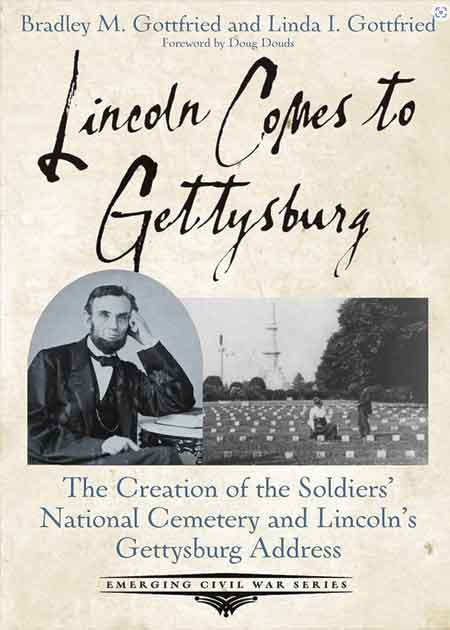By Bradley M. Gottfried and Linda J. Gottfried.
El Dorado Hills, CA: Savas Beatie, 2021.
ISBN 978-1-61121-559-5.
Photographs. Maps. Pp. xxi, 170.
$14.95.
A welcome addition to the Emerging Civil War series published by Savas Beatie, Lincoln Comes to Gettysburg is the second book co-authored by Bradley and Linda Gottfried. Subtitled, The Creation of the Soldiers’ National Cemetery and Lincoln’s Gettysburg Address, the authors provide a detailed analysis of events surrounding the establishment of the National Cemetery and the visit by President Abraham Lincoln and his notable address. The authors share details known and give clues concerning those less certain. For example, even newspaper accounts of Lincoln’s visit differ. Lincoln Comes to Gettysburg “to tell the story of the interface between the battle, the death and burial of so many young men, the Soldiers Cemetery creation, and Lincoln’s immortal visit” (p. viii).
The fighting at Gettysburg enveloped the town; the arrival of the soldiers, the encampments, and the sights, sounds, and odors of the battle all permeated the community. Regardless of how a resident felt about the war, there was no way to avoid it. Soldiers took over farms and homes. Even the Lutheran Seminary on the edge of town became ensnared in the battle as its elevation made it an important observation post.
After the battle, the townspeople quickly realized the need to bury the many bodies deteriorating in the hot summer sun. The heat, foraging animals, the arrival of family members to retrieve their loved ones, and the surge of souvenir hunters called for swift action. The authors provide clear insight to the issues facing the town’s residents.
The idea of creating a cemetery for the honored dead came with an assortment of issues around location, control, responsibility and other matters. It is unclear who came up with the idea for a national cemetery, but the initial action to address the need for action came from Pennsylvania Governor Andrew Curtin, who brought in the 36th Pennsylvania Volunteer Militia to begin removing the wounded, burying the dead, and collecting military weapons and equipment from the battlefield (p. 10).
While two local attorneys, David Wills and David McConaughy, competed to win the governor’s support for differing plans, Curtin sought the support of other state governors to help with the dead from their states and the means for clearing the battlefield. The solution was to establish a new cemetery adjacent to Evergreen Cemetery. This became the first national military cemetery. The authors provide details on the process of securing the land and respectfully burying the many soldiers who fell at Gettysburg.
The process of establishing the cemetery over, Governor Curtin and the town’s leaders prepared for a dedication ceremony. President Lincoln was invited but his attendance was uncertain up to the last minute. On the day of the dedication, Lincoln continued to refine his speech and rose to the occasion. His remarks were so short that the official photographer failed to get his camera set up in time to get a photo of Lincoln during the speech. This led to the debate about exactly where Lincoln stood. Regardless of the exact details of this important event, Bradley and Linda Gottfried provide an easily readable story of what took place to establish this cemetery and give us a speech memorized by so many.
Lincoln Comes to Gettysburg features numerous photographs and six maps to help readers understand the people and geography of the events. One critique is that the publisher chose to place the book’s citations online rather than in the book. Nevertheless, anyone visiting Gettysburg will find this book a helpful guide.
Chaplain (Lieutenant Colonel)
Kenneth M. Ruppar, USA-Ret.
Chesterfield, Virginia
